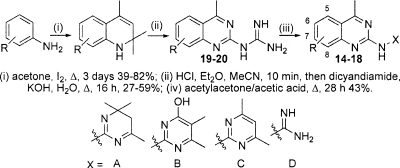TABLE 3.
Physicochemical evaluation and in vitro metabolism in human liver microsomes of the basic benzhydryl and nitrogenous heterocycle classes
The relative loss of the parent compound and the formation of metabolic products following incubation in human liver microsomes were determined by liquid chromatography-mass spectrometry. The concentration of the test compound versus time was fitted to an exponential decay function to determine the first-order rate constant for substrate depletion. This rate constant was used to calculate the in vitro intrinsic clearance (CLint) and the hepatic extraction ratio (EH).
In vitro metabolic stability groupings are as follows: very high, predicted hepatic extraction ratio (EH) of >0.95; high, predicted EH of 0.7 to 0.95; intermediate, predicted EH of 0.3 to 0.7; low, predicted EH of <0.3.
Calculated value.
The two pKa values shown for each form of compound 14 are for the ionization of their pyrimidine and quinazoline sites, respectively.
Measured using a chromatographic elogD method (35).
Measured using nephelometry (5).

